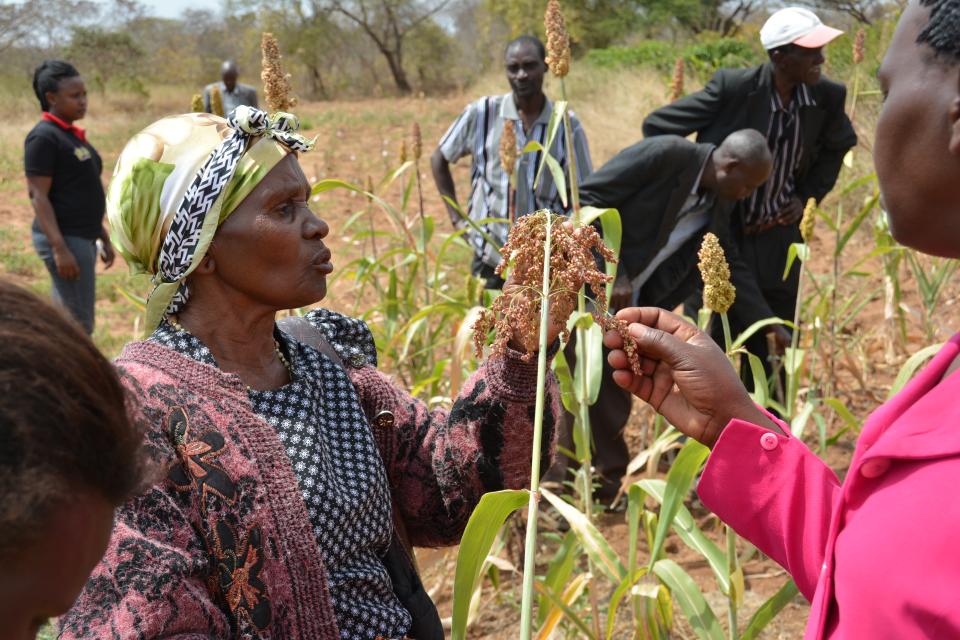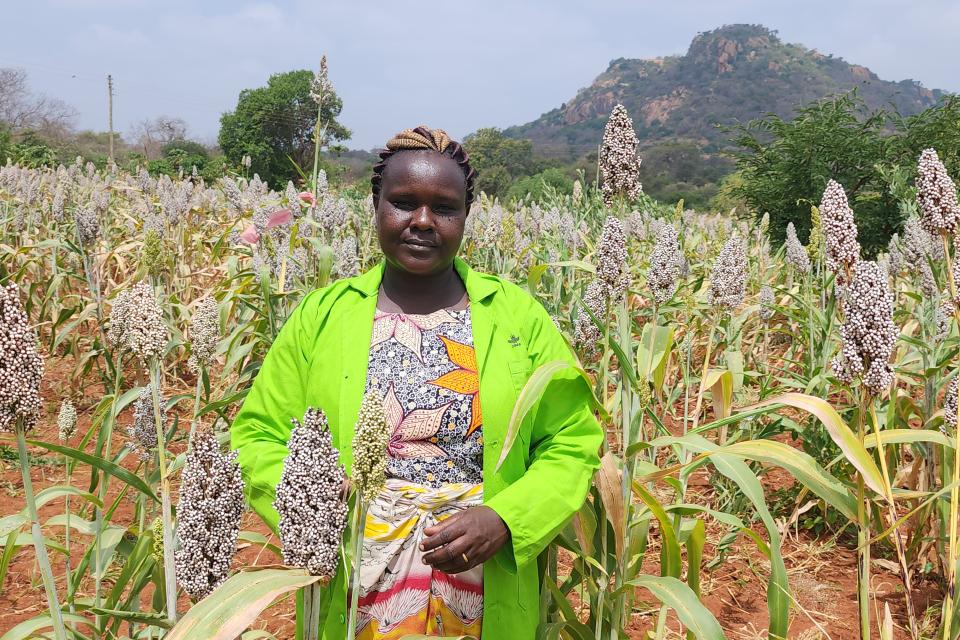

Welcome to Wonder Farm in Kenya's Makueni County
Women leader farmers in Kenya demonstrate an array of climate-smart innovations to their local community - and the whole nation.
A recent field visit to the farming communities of Kenya’s Makueni County demonstrated how access to enhanced climate information services (CIS) and validated innovations for climate-smart agriculture (CSA) have improved livelihoods and the resilience of a community in the arid and semi-arid regions of Kenya, which make up 89 percent of the country’s land area.
Across three Kenyan counties, such innovations have reached 54,300 people so far through innovative partnerships between the county governments and organizations like the Association of Women in Agriculture Kenya (AWAK) who have been connected to the science of CGIAR, the world’s largest publicly funded research partnership for food security.
These innovations, developed by CGIAR research centers like the Alliance of Biodiversity International-CIAT (The Alliance), the International Research Institute for Semi-Arid Tropics (ICRISAT) and the International Livestock Research Institute (ILRI), are now being delivered on a larger scale—reaching more farmers—thanks to the support of the Accelerating Impacts of CGIAR Climate Research for Africa (AICCRA) project.
To the farms
International partners of the AICCRA project visited a selection of the many project sites across Kenya, taking in a day-long tour of several farms where innovations in CIS and CSA are being delivered with local partners.
Two of those farms belong to Esther Mutuku and Phoebe Mwangangi, smallholder farmers who live in the town of Makindu, in Makueni County.
Esther and Phoebe have both been outstanding ‘Lead Farmers’ who have accessed and used innovative and validated technologies, digital platforms and new systems that help them access, for example, drought-tolerant and early maturing seeds.
These seeds have helped them strengthening their capacity to cope to the changing climate in Makueni, like elsewhere in Kenya.
At our first stop in Makueni County, visitors witnessed community seed production, a technically demanding practice that is the foundation for establishing a more resilient and sustainable seed system for farmers.
Esther grows maize, sorghum, cowpeas, and green grams on her five-acre farm in Maangi-Uvungu village.
Trained by AICCRA in community seed production, pest and disease control, harvest techniques and Good Agricultural Practices - called GAPs - which are a certification system for agriculture specifying procedures.
Esther now successfully grows drought-tolerant green grams on 2 acres. Esther harvested 7 bags (630 kg) of green grams in the last growing season. In April 2024, she sold her seeds to ICRISAT, earning enough to cover her children’s school fees.
Community seed banks like Esther’s are important hubs for gathering, preserving, and distributing seeds to farmers, providing access to improved varieties not typically available through ‘agrodealers’ – often small- and medium-scale enterprises (SMEs) who buy and sell agricultural inputs like fertilizer, seeds and chemicals.
AICCRA is currently training more farmers in community seed production and storage techniques.
Leading by example: A visit to farmer-led demonstration fields
Not far from Esther’s farm you will find Phoebe Mwangangi’s. Phoebe’s is one of 30 demonstration fields that is implementing CSA practices on a mixed crop-livestock farm, with four acres dedicated to crops and six acres for livestock grazing.
Phoebe participated in a climate-smart training program in 2021, which was supported by AICCRA. Along with 25 other women farmers, Phoebe was introduced to drought-tolerant and early maturing seeds such as sorghum, pearl millet, and green gram.
She also relished the opportunity for training in essential CSA practices like rainwater harvesting, intercropping with legumes, crop diversification, conservation tilling, and pest and disease control.
Phoebe’s farm has been reconfigured as a working demonstration plot, meaning she can easily showcase the application of CSA practices to farmers from near and far away—as the AICCRA visitors themselves enjoyed—encouraging them to adopt the practices after seeing how it works.
Across three counties in Kenya, 17,300 farmers have visited such demo sites for farmer-to-farmer learnings, through the collaboration fostered between the county governments, AICCRA and groups like AWAK.
“We should continue adopting more innovations and partnering with farmers to support them in adopting these practices and technologies. We do this as each of the demo farmers connects with 10 other farmers to show them their practices and how to integrate things like using biological control to fight diseases. These 10 farmers adopt the practices then serve as demonstration farmers to 10 more farmers. 10-10-10 we multiply our impact.”
Phoebe Mwangangi

Joining the visitors to capture these stories was Citizen TV, a station with one of the largest audiences in Kenya.
Playback their reporting from Esther and Phoebe’s farms:
From farm to forum
The next day AICCRA held a public forum in the Kenyan capital Nairobi, inspired by the stories that were heard in Makueni County.
The purpose of this public forum was to showcase the impact of new and strengthened partnerships between Kenya’s leading institutions, which are helping Kenya’s smallholder farmers become more resilient under climate change.
For example, participants heard how a partnership between Kenya Meteorological Department (KMD) and Kenya Agricultural and Livestock Research Organization (KALRO) is delivering actionable recommendations to hundreds of thousands of smallholder farmers, boosting yields, incomes, and community resilience.
Attendees heard how new technologies and practices are helping herders in Kenya’s dryland areas not only cope but proactively address climate risk, understanding the role of CSA in key sectors and exploring how innovations can be delivered at scale through peer-to-peer education.
Opening the event on behalf of Kenya’s Cabinet Secretary for Environment and Climate Change was Pacifica F. Achieng Ogola who serves as Director for Climate Change at Kenya’s Ministry of Environment and Forestry.
“To address this challenge, the Kenyan government has been investing in the agricultural sector, enabling it to adapt to climate change. Now more than ever, farmers need accurate real-time climate information to help them plan their agricultural activities. We must improve the quality of climate information services. And we need to foster the adoption of agricultural practices that are climate-smart, making sure that women and youth are at the front of the queue.”
Pacifica F. Achieng Ogola, Director for Climate Change, Kenya Ministry of Environment and Forestry
Several speeches were followed by four panel discussions on climate services for farmers, drought resilient crops, climate resilient livestock, and enabling environments for climate action.
Check out highlights from the event:
In closing the event, AICCRA’s team leader in Kenya Todd Crane remarked:
“The content of the day ran all the way from the farms to the treasury. One thing that really struck me….it’s about ‘people plus platform’. Yes, we have technology platforms…but the platform without the people does not go very far.”
He added:
“We have educational platforms, we have technological platforms, we have digital information exchange platforms. But what brings them alive and makes them effective is the way people engage with them, and the way they engage with people.”
Authors
Kristen Tam, Communication and Knowlege Management Africa Fellow, ILRI
Rhys Bucknall-Wiliams, Global Communications Advisor, AICCRA
Related content

Public Forum: Climate change in Kenya's drylands - How powerful new partnerships support resilient smallholder farmers
Kenyatta International Convention Center (KICC), Nairobi
Drought tolerant crops provide relief for smallholder farmers in Kenya's drylands
